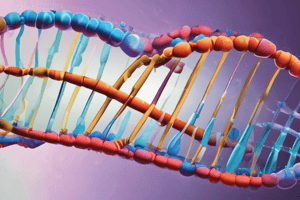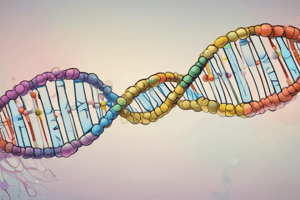Podcast
Questions and Answers
What process refers to the duplication of DNA before cell division?
What process refers to the duplication of DNA before cell division?
- Mutation
- Transcription
- Translation
- Replication (correct)
Which enzyme is responsible for adding new bases to the growing daughter strand during DNA replication?
Which enzyme is responsible for adding new bases to the growing daughter strand during DNA replication?
- Helicase
- Telomerase
- DNA Polymerase (correct)
- DNA Ligase
What term describes the nature of DNA replication where half of the original molecule is retained in each daughter molecule?
What term describes the nature of DNA replication where half of the original molecule is retained in each daughter molecule?
- Semi-conservative (correct)
- Conservative
- Dispersive
- Linear
Which structure is particularly difficult to replicate, causing chromosomes to shorten with each cell division?
Which structure is particularly difficult to replicate, causing chromosomes to shorten with each cell division?
During DNA replication, which direction do the sugar-phosphate backbones run?
During DNA replication, which direction do the sugar-phosphate backbones run?
What is the composition of a nucleotide in DNA?
What is the composition of a nucleotide in DNA?
Which nitrogenous bases are classified as purines?
Which nitrogenous bases are classified as purines?
What discovery was made by Erwin Chargaff regarding DNA base pairing?
What discovery was made by Erwin Chargaff regarding DNA base pairing?
How did Rosalind Franklin contribute to the understanding of DNA's structure?
How did Rosalind Franklin contribute to the understanding of DNA's structure?
What allows the two strands of DNA to separate easily?
What allows the two strands of DNA to separate easily?
What was the primary goal of Oswald Avery's research?
What was the primary goal of Oswald Avery's research?
Which statement accurately describes transformation in bacterial cells?
Which statement accurately describes transformation in bacterial cells?
What is one of the essential functions of DNA according to the content?
What is one of the essential functions of DNA according to the content?
Which of the following is NOT a step in the life cycle of a phage as described?
Which of the following is NOT a step in the life cycle of a phage as described?
Who performed critical experiments in the study of viruses that built upon Avery's research?
Who performed critical experiments in the study of viruses that built upon Avery's research?
What is the primary role of RNA in protein synthesis?
What is the primary role of RNA in protein synthesis?
Which statement accurately describes a difference between DNA and RNA?
Which statement accurately describes a difference between DNA and RNA?
What are exons in the context of RNA?
What are exons in the context of RNA?
Where does transcription occur in prokaryotic cells?
Where does transcription occur in prokaryotic cells?
What is the function of a promoter in RNA synthesis?
What is the function of a promoter in RNA synthesis?
What is the role of tRNA in protein synthesis?
What is the role of tRNA in protein synthesis?
How many codons are needed to specify 4 amino acids?
How many codons are needed to specify 4 amino acids?
Which component of a nucleotide differs between DNA and RNA?
Which component of a nucleotide differs between DNA and RNA?
What is the function of rRNA in the cell?
What is the function of rRNA in the cell?
Which of the following statements is true regarding codons?
Which of the following statements is true regarding codons?
What is the primary role of helicase during DNA replication?
What is the primary role of helicase during DNA replication?
Which enzyme is responsible for connecting DNA fragments during replication?
Which enzyme is responsible for connecting DNA fragments during replication?
What is the correct order of processes in protein synthesis?
What is the correct order of processes in protein synthesis?
What is the role of homeotic genes in body development?
What is the role of homeotic genes in body development?
What is the primary role of tRNA during the initiation phase of protein synthesis?
What is the primary role of tRNA during the initiation phase of protein synthesis?
Which type of mutation results in a change of an amino acid to a stop codon?
Which type of mutation results in a change of an amino acid to a stop codon?
What kind of bond connects amino acids in a protein chain?
What kind of bond connects amino acids in a protein chain?
Which type of mutation shifts the reading frame of the genetic message?
Which type of mutation shifts the reading frame of the genetic message?
What occurs during the elongation phase of translation?
What occurs during the elongation phase of translation?
What type of bonds hold the nucleotides together in the structure of nucleic acids?
What type of bonds hold the nucleotides together in the structure of nucleic acids?
Which component of protein synthesis functions as a stop signal?
Which component of protein synthesis functions as a stop signal?
What best describes spontaneous mutations?
What best describes spontaneous mutations?
What is the first step in the process of gene expression?
What is the first step in the process of gene expression?
What role do transcription factors play in gene expression?
What role do transcription factors play in gene expression?
Flashcards
What did Frederick Griffith discover?
What did Frederick Griffith discover?
Frederick Griffith discovered that a chemical substance within bacteria could be transferred from one bacterium to another, causing a change in its characteristics. This discovery hinted at the nature of genetic material.
What was Avery's group trying to find?
What was Avery's group trying to find?
Oswald Avery and his team aimed to isolate the specific molecule responsible for bacterial transformation. They wanted to determine whether DNA, RNA, or protein was the carrier of genetic information.
What is a phage?
What is a phage?
A phage is a virus that infects bacteria. It consists of a protein coat surrounding genetic material (DNA or RNA) and uses the host bacterium's machinery to replicate itself.
What are the functions of DNA?
What are the functions of DNA?
Signup and view all the flashcards
What is transformation in bacteria?
What is transformation in bacteria?
Signup and view all the flashcards
What are the building blocks of DNA?
What are the building blocks of DNA?
Signup and view all the flashcards
What are the four nitrogenous bases in DNA?
What are the four nitrogenous bases in DNA?
Signup and view all the flashcards
What is the difference between purines and pyrimidines?
What is the difference between purines and pyrimidines?
Signup and view all the flashcards
What is Chargaff's Rule?
What is Chargaff's Rule?
Signup and view all the flashcards
What is the structure of DNA?
What is the structure of DNA?
Signup and view all the flashcards
DNA Replication
DNA Replication
Signup and view all the flashcards
Semi-Conservative Replication
Semi-Conservative Replication
Signup and view all the flashcards
DNA Polymerase
DNA Polymerase
Signup and view all the flashcards
DNA Ligase
DNA Ligase
Signup and view all the flashcards
Telomeres
Telomeres
Signup and view all the flashcards
What is RNA transcription?
What is RNA transcription?
Signup and view all the flashcards
Name three key differences between DNA and RNA.
Name three key differences between DNA and RNA.
Signup and view all the flashcards
What are the three main types of RNA?
What are the three main types of RNA?
Signup and view all the flashcards
What is the role of promoters in RNA transcription?
What is the role of promoters in RNA transcription?
Signup and view all the flashcards
What is the difference between introns and exons?
What is the difference between introns and exons?
Signup and view all the flashcards
What is a codon?
What is a codon?
Signup and view all the flashcards
How many codons are needed for 4 amino acids?
How many codons are needed for 4 amino acids?
Signup and view all the flashcards
What is the genetic code?
What is the genetic code?
Signup and view all the flashcards
What is mRNA's role?
What is mRNA's role?
Signup and view all the flashcards
What is tRNA's role?
What is tRNA's role?
Signup and view all the flashcards
What is the role of Helicase in DNA replication?
What is the role of Helicase in DNA replication?
Signup and view all the flashcards
What is the function of DNA Polymerase in DNA replication?
What is the function of DNA Polymerase in DNA replication?
Signup and view all the flashcards
Why is Primase essential in DNA replication?
Why is Primase essential in DNA replication?
Signup and view all the flashcards
What is the function of Ligase in DNA replication?
What is the function of Ligase in DNA replication?
Signup and view all the flashcards
What is the difference between transcription and translation?
What is the difference between transcription and translation?
Signup and view all the flashcards
Anticodon
Anticodon
Signup and view all the flashcards
Codon
Codon
Signup and view all the flashcards
Homeotic Genes
Homeotic Genes
Signup and view all the flashcards
Hox Genes
Hox Genes
Signup and view all the flashcards
Gene Mutations
Gene Mutations
Signup and view all the flashcards
What is the role of tRNA in protein synthesis?
What is the role of tRNA in protein synthesis?
Signup and view all the flashcards
How does the anticodon on tRNA contribute to protein synthesis?
How does the anticodon on tRNA contribute to protein synthesis?
Signup and view all the flashcards
What is the function of stop codons in translation?
What is the function of stop codons in translation?
Signup and view all the flashcards
What happens during the elongation phase of translation?
What happens during the elongation phase of translation?
Signup and view all the flashcards
What is the role of ribosomes in translation?
What is the role of ribosomes in translation?
Signup and view all the flashcards




